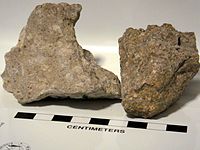
Photo from wikipedia
Boreal mire ecosystems are predicted to experience warmer air temperatures as well as changed deposition loads of nitrogen and sulfur during the coming century. In this study, we hypothesized that… Click to show full abstract
Boreal mire ecosystems are predicted to experience warmer air temperatures as well as changed deposition loads of nitrogen and sulfur during the coming century. In this study, we hypothesized that vegetation changes that accompany these new environmental conditions alter the chemical composition of peat. To test this hypothesis, we quantified changes in peat geochemistry (Al, Ca, Fe, Mg, Na, P, Pb, and Zn) that have occurred in field manipulation plots exposed to 12 years of warming and nitrogen and sulfur additions in a nutrient-poor boreal mire. In contrast to non-nutrients with a mainly atmospheric origin (i.e. Pb), Al-normalized inventories of micronutrients (Zn and Fe) and macronutrients (P and Ca) were significantly (P < 0.05) higher as a result of warming. For P and Ca, enrichments were also induced by nitrogen additions alone. These results suggest that mires evolving under increasing temperatures and availability of nitrogen are around two times more effective in storing nutrients in the accumulating peat. Our study provides the first empirical evidence that predicted changes in climate and nitrogen deposition scenarios will increase the retention of Ca, Fe, P, and Zn in surface peat of boreal mires in the near future, which may cause a depletion of nutrients released to inland waters dependent on mire inputs.
Journal Title: Applied Geochemistry
Year Published: 2017
Link to full text (if available)
Share on Social Media: Sign Up to like & get
recommendations!